Michael Swanwick's Blog, page 194
May 16, 2012
J. K. Klein Remembered
.
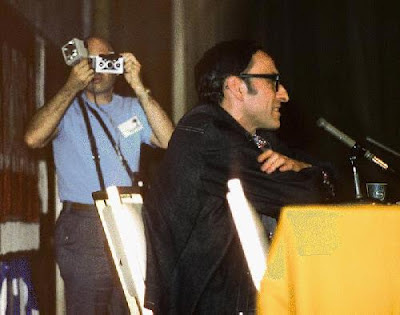
Jay Kay Klein died this past Sunday, May 13. That's him up above, photographing Roger Zelazny at Capclave II, the 1974 Worldcon, and it's how those of us who knew him will remember him. Jay Kay was not a great photographer, but he was an important one. For something like fifty years, he carried his camera to science fiction conventions and snapped photos of writers and the other denizens of our subculture. He took thousands of photographs over the course of his life and consequently preserved a slice of our literary heritage.
I vividly remember one conversation with him at the 2000 Worldcon in Philadelphia. J.K. was feeling nostalgic. "I was at the first Philadelphia Worldcon in 1953," he told me, "and I know things about it that nobody else remembers."
"Oh, yeah? Like what?" I asked.
"Like the fact that I was there."
Rest in peace, Jay Kay. You're not forgotten.
And as always . . .
I'm on the road. I'll be home tonight and at the Nebula banquet on Saturday. But on Monday I fly to Ekaterinburg for Aelita, Russia's oldest science fiction convention, and I won't be back until June 1. I'll do my best to post from Russia while I'm there but the Intertubes haven't reached the degree of saturation in Siberia that they have in the States. So there may be some lengthy silences ahead.
*

Jay Kay Klein died this past Sunday, May 13. That's him up above, photographing Roger Zelazny at Capclave II, the 1974 Worldcon, and it's how those of us who knew him will remember him. Jay Kay was not a great photographer, but he was an important one. For something like fifty years, he carried his camera to science fiction conventions and snapped photos of writers and the other denizens of our subculture. He took thousands of photographs over the course of his life and consequently preserved a slice of our literary heritage.
I vividly remember one conversation with him at the 2000 Worldcon in Philadelphia. J.K. was feeling nostalgic. "I was at the first Philadelphia Worldcon in 1953," he told me, "and I know things about it that nobody else remembers."
"Oh, yeah? Like what?" I asked.
"Like the fact that I was there."
Rest in peace, Jay Kay. You're not forgotten.
And as always . . .
I'm on the road. I'll be home tonight and at the Nebula banquet on Saturday. But on Monday I fly to Ekaterinburg for Aelita, Russia's oldest science fiction convention, and I won't be back until June 1. I'll do my best to post from Russia while I'm there but the Intertubes haven't reached the degree of saturation in Siberia that they have in the States. So there may be some lengthy silences ahead.
*
Published on May 16, 2012 08:32
May 15, 2012
Johnny Carson's Poets
.
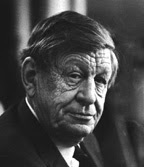
Last night I watched a documentary about Johnny Carson. If you weren't there back when there were only three networks and maybe (if you were lucky) a public television station, you have no idea what a Colossus the guy was. He bestrode the earth.
My fantasy job is to be an archaeologist for his Tonight Show recordings. I'd like to delve deep deep deep into the archives and put together compilation disks. Because back when there were so few media outlets a man with a popular show like that could get anybody he wanted. Not just entertainers. Everyone.
Back then, before video recorders, to see one of the shows, you had to stay up late. Probably you were lying in bed. Sometimes it was after sex. So it was an intimate experience.
Vividly, I remember when W. H. Auden appeared on the show. Carson introduced him and the poet walked on stage to the most intimidated applause the show had ever heard. "It's good to have you here, Wystan," Carson said.
"It's great to be here, Johnny," Auden replied, beaming.
"Have you brought any poetry with you to read?" Carson asked.
"Why, yes, I have." Auden pulled a sheet of paper from his pocket. There was a ghastly silence. "This is from Academic Graffiti ." Then he read:
A moment of absolute astonishment. Then thunderous applause as the audience realized in abject relief that, "OhmygodigotitIgotithesnotgoingtohuimiliate us."
Avuncular, amused, Auden leaned back and was very very happy.
And the night before . . .
Believe it or not, Rod McKuen (back then emblematic of bad Hallmark-style poetry) appeared on the Carson Show one night before Auden did. He was expansive. He was happy. Because Carson never played "gotcha." But at the end of what must have been an extremely pleasant night for him, Carson posed the final question of the evening: "W.H. Auden is going to be here tomorrow. I wonder if you'd tell us what you think of him."
Looking like a deer caught in the headlights, McKuen said, "Ithinkhesaveryverygreatpoet."
So I conclude . . .
It would be great if somebody (not me; I don't need the money) would troll through the entirety of the Tonight Show and collect all the clips of significant poets being interviewed by Johnny. It would be a fascinating document on the intersection of poetry and commerce. And I think it would show that injecting money into the poetry biz would not be an entirely bad thing.
*

Last night I watched a documentary about Johnny Carson. If you weren't there back when there were only three networks and maybe (if you were lucky) a public television station, you have no idea what a Colossus the guy was. He bestrode the earth.
My fantasy job is to be an archaeologist for his Tonight Show recordings. I'd like to delve deep deep deep into the archives and put together compilation disks. Because back when there were so few media outlets a man with a popular show like that could get anybody he wanted. Not just entertainers. Everyone.
Back then, before video recorders, to see one of the shows, you had to stay up late. Probably you were lying in bed. Sometimes it was after sex. So it was an intimate experience.
Vividly, I remember when W. H. Auden appeared on the show. Carson introduced him and the poet walked on stage to the most intimidated applause the show had ever heard. "It's good to have you here, Wystan," Carson said.
"It's great to be here, Johnny," Auden replied, beaming.
"Have you brought any poetry with you to read?" Carson asked.
"Why, yes, I have." Auden pulled a sheet of paper from his pocket. There was a ghastly silence. "This is from Academic Graffiti ." Then he read:
John Milton
Never stayed at the Hilton
Hotel.
Which was just as well.
A moment of absolute astonishment. Then thunderous applause as the audience realized in abject relief that, "OhmygodigotitIgotithesnotgoingtohuimiliate us."
Avuncular, amused, Auden leaned back and was very very happy.
And the night before . . .
Believe it or not, Rod McKuen (back then emblematic of bad Hallmark-style poetry) appeared on the Carson Show one night before Auden did. He was expansive. He was happy. Because Carson never played "gotcha." But at the end of what must have been an extremely pleasant night for him, Carson posed the final question of the evening: "W.H. Auden is going to be here tomorrow. I wonder if you'd tell us what you think of him."
Looking like a deer caught in the headlights, McKuen said, "Ithinkhesaveryverygreatpoet."
So I conclude . . .
It would be great if somebody (not me; I don't need the money) would troll through the entirety of the Tonight Show and collect all the clips of significant poets being interviewed by Johnny. It would be a fascinating document on the intersection of poetry and commerce. And I think it would show that injecting money into the poetry biz would not be an entirely bad thing.
*
Published on May 15, 2012 17:06
May 14, 2012
THIS is How You Start a Story
.
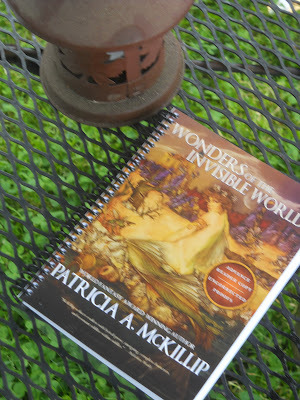
On those rare but rewarding occasions when I teach, the most common error I see is beginning a story with three-to-seven pages of exposition of everything the writer thinks the reader needs to know before the story can actually start. They're invariably shocked when I cross out all of that and somewhere deep within the text write "Begin Here."
This comes to mind because I've been reading an Advance Reader Copy of Patrickia A. McKillip's new collection Wonders of the Invisible World . (Forthcoming from Tachyon Publications). The title story of which opens as follows:
That is a terrific opening. It's solid as an oak plank and as simple as a Shaker broom. You could rap your knuckles on it. It evokes all the senses. It has wit and rhythm. It sets the scene beautifully. Most importantly, it gets you right into the story.
And McKillip hasn't wasted a word telling you how the protagonist got there in the first place, who the woman was (for she is no angel after all, which is why the language is so unangelic), what issues she suffers from, how she feels about her employer and he about her, or the history of the technology that makes the situation in the first paragraph possible. All these things, except for the last, you'll learn over the course of the story. Which is the right place for them.
And how does one write an opening that good? By working long and hard to learn one's craft and then writing the very best one can. It's as simple -- and as hard -- as that.
*


On those rare but rewarding occasions when I teach, the most common error I see is beginning a story with three-to-seven pages of exposition of everything the writer thinks the reader needs to know before the story can actually start. They're invariably shocked when I cross out all of that and somewhere deep within the text write "Begin Here."
This comes to mind because I've been reading an Advance Reader Copy of Patrickia A. McKillip's new collection Wonders of the Invisible World . (Forthcoming from Tachyon Publications). The title story of which opens as follows:
I am the angel sent to Cotton Mather. It took me some time to get his attention. He lay on the floor with his eyes closed; he prayed fervently, sometimes murmuring, sometimes shouting. Apparently the household was used to it. I heard footsteps pass his study door; a woman -- his wife Abigail? -- called to someone: "If your throat is no better tomorrow, we'll have Phillip pee in a cup for you to gargle." From the way the house smelled, Phillip didn't bother much with cups. Cotton Mather smelled of smoke and sweat and wet wool. Winter had come early. The sky was black, the ground was white, the wind pinched like a witch and whined like a starving dog. There was no color in the landscape and no mercy. Cotton Mather prayed to see the invisible world.
He wanted an angel.
That is a terrific opening. It's solid as an oak plank and as simple as a Shaker broom. You could rap your knuckles on it. It evokes all the senses. It has wit and rhythm. It sets the scene beautifully. Most importantly, it gets you right into the story.
And McKillip hasn't wasted a word telling you how the protagonist got there in the first place, who the woman was (for she is no angel after all, which is why the language is so unangelic), what issues she suffers from, how she feels about her employer and he about her, or the history of the technology that makes the situation in the first paragraph possible. All these things, except for the last, you'll learn over the course of the story. Which is the right place for them.
And how does one write an opening that good? By working long and hard to learn one's craft and then writing the very best one can. It's as simple -- and as hard -- as that.
*
Published on May 14, 2012 09:49
May 13, 2012
Marianne's Dilemma
.

The Ridge Runners sponsored a car show by Gorgas Park this Saturday. It looked like the parking lot in Heaven.
Marianne was admiring the 1930s roadster above. I told her that if she got one, she'd be required by law to buy a cape and mask and fight crime. So now she's considering it.
*

The Ridge Runners sponsored a car show by Gorgas Park this Saturday. It looked like the parking lot in Heaven.
Marianne was admiring the 1930s roadster above. I told her that if she got one, she'd be required by law to buy a cape and mask and fight crime. So now she's considering it.
*
Published on May 13, 2012 13:40
May 11, 2012
Mimmoths!
.
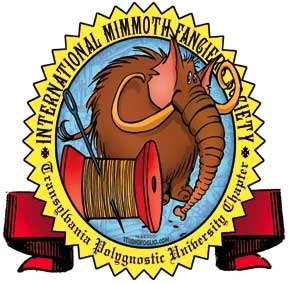
In yet another example of science imitating fiction, it turns out that something very much like Phil and Kaja Foglio's minuscule mammoths once actually existed.
A paper by Victoria L. Herridge and Adrian M. Lister in the Proceedings of the Royal Society identifies fossils once thought to be those of dwarf elephants as actually belonging to mastodons that stood only a meter high at the shoulder. Which is to say that, if only they weren't extinct, they'd make great pets.
Mammuthus creticus once roamed Pleistocene Crete and there's even some suggestion (see below) that they might have survived into historical times.
You can read io9's account here. The abstract of the original paper is here. And there's a great related blog post about the Rekhmire tomb elephant here.
And there's pleasant news for me . . .
I've just heard that Dancing with Bears is on the final ballot for the John W. Campbell Memorial Award. The other ten nominees are:
Ernest Cline Ready Player One
Kathleen Ann Goonan This Shared Dream
Will McIntosh Soft Apocalypse
China Miéville Embassytown
Christopher Priest The Islanders
Joan Slonczewski The Highest Frontier
Lavie Tidhar Osama
Daniel H. Wilson Robopocalypse
Gene Wolfe Home Fires
Rob Ziegler Seed
Congratulations to everyone on the list. Well done, us!
*

In yet another example of science imitating fiction, it turns out that something very much like Phil and Kaja Foglio's minuscule mammoths once actually existed.
A paper by Victoria L. Herridge and Adrian M. Lister in the Proceedings of the Royal Society identifies fossils once thought to be those of dwarf elephants as actually belonging to mastodons that stood only a meter high at the shoulder. Which is to say that, if only they weren't extinct, they'd make great pets.
Mammuthus creticus once roamed Pleistocene Crete and there's even some suggestion (see below) that they might have survived into historical times.
You can read io9's account here. The abstract of the original paper is here. And there's a great related blog post about the Rekhmire tomb elephant here.
And there's pleasant news for me . . .
I've just heard that Dancing with Bears is on the final ballot for the John W. Campbell Memorial Award. The other ten nominees are:
Ernest Cline Ready Player One
Kathleen Ann Goonan This Shared Dream
Will McIntosh Soft Apocalypse
China Miéville Embassytown
Christopher Priest The Islanders
Joan Slonczewski The Highest Frontier
Lavie Tidhar Osama
Daniel H. Wilson Robopocalypse
Gene Wolfe Home Fires
Rob Ziegler Seed
Congratulations to everyone on the list. Well done, us!
*
Published on May 11, 2012 09:53
May 10, 2012
Thursday's Wretched Refuse
.
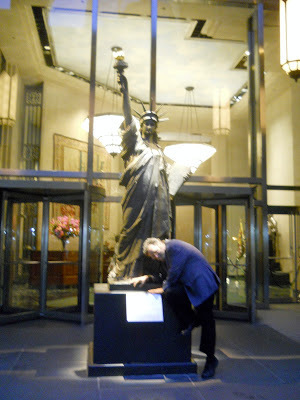
It's Thursday and I'm working furiously on the story I promised I'd have done by the time I left for Aelita, so today's post will be brief. Just a few scrips and scraps, the wretched refuse of the week.
Paleoartist Robert Walters called me on my word choice in Monday's post on imaginary artist "Celandro Sfatato," in which I wrote, "I applaud this work of fraudulent art." Fraudulent? Bob asked. Really? He then pointed out that, whether good or bad, art is art. Even at its worst, it is not fraudulent.
Right he is. I stand corrected.
And over at SF Signal . . .
Reviewer Jaym Gates gave my latest novel, Dancing with Bears a glowing review. The blurbable excerpts of which are:
You can read the whole thing here.
Above: There I am, with the original model for the Statue of Liberty, yearning to breathe free.
*

It's Thursday and I'm working furiously on the story I promised I'd have done by the time I left for Aelita, so today's post will be brief. Just a few scrips and scraps, the wretched refuse of the week.
Paleoartist Robert Walters called me on my word choice in Monday's post on imaginary artist "Celandro Sfatato," in which I wrote, "I applaud this work of fraudulent art." Fraudulent? Bob asked. Really? He then pointed out that, whether good or bad, art is art. Even at its worst, it is not fraudulent.
Right he is. I stand corrected.
And over at SF Signal . . .
Reviewer Jaym Gates gave my latest novel, Dancing with Bears a glowing review. The blurbable excerpts of which are:
A rollicking, weird ride through a vibrant, post-apocalyptic world. . . . I’ve always enjoyed Swanwick’s prose, and it is up to its usual standards here. There is a particular cadence to be found in works translated from Russian, and Swanwick somehow manages to capture that lyrical quality here. . . . This is a love-it-or-hate-it book, the literary equivalent of Turkish coffee: intense, rich and complex. My personal response to this book is unmitigated glee, because it is just so fun, and too little SF is fun. Approach with care, and allow plenty of time to read straight through.
You can read the whole thing here.
Above: There I am, with the original model for the Statue of Liberty, yearning to breathe free.
*
Published on May 10, 2012 06:52
May 9, 2012
A Sad and Lovely Tale
.
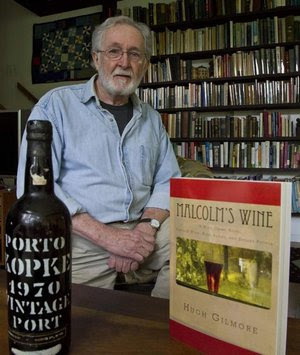
In this morning's Philaelphia Inquirer , there's an article about Hugh Gilmore, who once ran one of my favorite used book stores ever in Chestnut Hill, and who has self-published his a novel inspired by the death of his son Colin who was killed by a drunk driver at age 18.
No parent ever really recovers from that kind of loss. Over the years, Gilmore wrote two novels containing a character who has lost a son, and began a memoir, none of them published. A year and a half ago, he decided to try his hand at a mystery.
In staff writer Melissa Dribben's words:
When Malcolm's Wine was finished, Gilmore sent out something like a hundred queries to agents (agents are far harder to acquire than publishers), with no luck. So at the urging of friends he self-published the book. In February, a friend who runs a literary arts center held a book launch for him.
So far, the book has sold about fifty copies on Kindle and another fifty print-on-demand paperbacks. That's probably not enough to cover the costs of self-publishing. "I sell as many as I push," Gilmore says.
So is this a sad story or a happy one? I can't decide. One hundred sales, including friends and people who were curious to see what a launch party was like and may never actually finish the book is a negligible readership. On the other hand, without the ability to self-publish, the book would have gone into the drawer and probably never come out.
But it's a story that I think all new writers should contemplate long and hard before deciding to self-publish.
You can read the newspaper article here.
Above: Photo by Darren M. Warren, staff photographer for the Inquirer. I'm pretty sure this is fair use, but if I'm wrong I'll take it down immediately.
*

In this morning's Philaelphia Inquirer , there's an article about Hugh Gilmore, who once ran one of my favorite used book stores ever in Chestnut Hill, and who has self-published his a novel inspired by the death of his son Colin who was killed by a drunk driver at age 18.
No parent ever really recovers from that kind of loss. Over the years, Gilmore wrote two novels containing a character who has lost a son, and began a memoir, none of them published. A year and a half ago, he decided to try his hand at a mystery.
In staff writer Melissa Dribben's words:
In 1970, when Colin was an infant, Gilmore bought a bottle of vintage wine, Porto Kopke. "I put this down to give to him when he turned 21," he says, setting the inky black bottle with the desiccated lip on the table.
The wine served as a symbol for all the sweetness he would never taste watching his son grow into a man. In the novel, the bottle is stolen and the father sets out after the thieves.
When Malcolm's Wine was finished, Gilmore sent out something like a hundred queries to agents (agents are far harder to acquire than publishers), with no luck. So at the urging of friends he self-published the book. In February, a friend who runs a literary arts center held a book launch for him.
So far, the book has sold about fifty copies on Kindle and another fifty print-on-demand paperbacks. That's probably not enough to cover the costs of self-publishing. "I sell as many as I push," Gilmore says.
So is this a sad story or a happy one? I can't decide. One hundred sales, including friends and people who were curious to see what a launch party was like and may never actually finish the book is a negligible readership. On the other hand, without the ability to self-publish, the book would have gone into the drawer and probably never come out.
But it's a story that I think all new writers should contemplate long and hard before deciding to self-publish.
You can read the newspaper article here.
Above: Photo by Darren M. Warren, staff photographer for the Inquirer. I'm pretty sure this is fair use, but if I'm wrong I'll take it down immediately.
*
Published on May 09, 2012 06:31
May 8, 2012
Kids! Don't Try This At Home
.
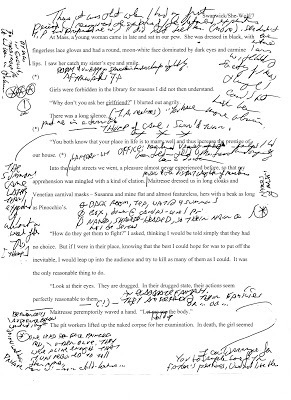
On those rare occasions when I teach writing, I'm sure to be asked, "What's your technique for writing?"
And my answer is invariably, "Oh, you don't want to do it my way."
I spent yesterday writing and at the end of it printed out what I had so far on a story I was rash enough to promise would be ready by the first of June. Which means that it has to be ready by the 20th of May, because I leave for Ekaterinburg, Russia on the 21st. Except that I'm one of the presenters at the Nebula Awards banquet on the 19th, so . . .
So, anyway, after I printed out the story, I went over it adding incidents, dialogue, description, and pertinent notes. Up above is one page. I spent all morning incorporating those changes into the text and expanding upon them.
It would have been a lot easier if only I could read my handwriting.
And for those who are curious . . .
The typed (*) means there's a gap in the plot I have to go back and fill in. The circled numeral one means there's a paragraph on the back of the sheet to add to the story. The three uncircled asterisks indicate a line break. The single circled asterisks indicate added text and the place where it goes. The three circled asterisks are to draw my attention to something important. I forget what the handwritten (!) means. Probably that a crucial scene has to be inserted there.
Like I said: You don't want to do it my way.
The story I'm working on is called "The She-Wolf's Hidden Grin." To be published maybe late this year, early next? It'll be interesting to see how much of the typed prose survives to the final version.
*

On those rare occasions when I teach writing, I'm sure to be asked, "What's your technique for writing?"
And my answer is invariably, "Oh, you don't want to do it my way."
I spent yesterday writing and at the end of it printed out what I had so far on a story I was rash enough to promise would be ready by the first of June. Which means that it has to be ready by the 20th of May, because I leave for Ekaterinburg, Russia on the 21st. Except that I'm one of the presenters at the Nebula Awards banquet on the 19th, so . . .
So, anyway, after I printed out the story, I went over it adding incidents, dialogue, description, and pertinent notes. Up above is one page. I spent all morning incorporating those changes into the text and expanding upon them.
It would have been a lot easier if only I could read my handwriting.
And for those who are curious . . .
The typed (*) means there's a gap in the plot I have to go back and fill in. The circled numeral one means there's a paragraph on the back of the sheet to add to the story. The three uncircled asterisks indicate a line break. The single circled asterisks indicate added text and the place where it goes. The three circled asterisks are to draw my attention to something important. I forget what the handwritten (!) means. Probably that a crucial scene has to be inserted there.
Like I said: You don't want to do it my way.
The story I'm working on is called "The She-Wolf's Hidden Grin." To be published maybe late this year, early next? It'll be interesting to see how much of the typed prose survives to the final version.
*
Published on May 08, 2012 10:36
May 7, 2012
Celando Sfatato
.
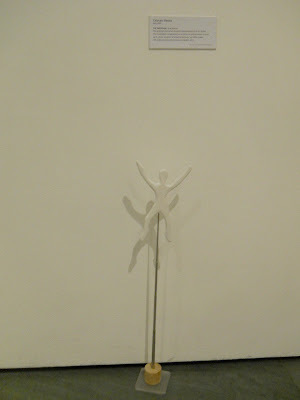
Last week after I left for NYC, Eileen Gunn wrote to ask if I'd found any Higgs bosons. Well, no, I didn't. But I found something equally odd.
I was in the Museum of Modern Art and in the hallway between the contemporary gallery and the cafe, saw the above piece. Contemplate it for a moment. The white-painted wooden man is about two feet high and is the only artwork on a long and otherwise blank well. The label is placed somewhere beteen waist and chest level.
If you google the artist's name you'll come up with exactly zero hits.
 Which means that somebody bought a ticket into MOMA, sat down on the bench and, removing pieces from his pocket, casually assembled the artwork. Then, surreptitiously, he glued the label to the wall. You can tell the label is not official because it's just a little crooked and the font doesn't match that on the museum's other labels.
Which means that somebody bought a ticket into MOMA, sat down on the bench and, removing pieces from his pocket, casually assembled the artwork. Then, surreptitiously, he glued the label to the wall. You can tell the label is not official because it's just a little crooked and the font doesn't match that on the museum's other labels.
I applaud this work of fraudulent art, minor though it may be. If it achieves nothing else, it demonstrates that you don't have to be an overachiever to get your work shown in a world-class museum.
*


Last week after I left for NYC, Eileen Gunn wrote to ask if I'd found any Higgs bosons. Well, no, I didn't. But I found something equally odd.
I was in the Museum of Modern Art and in the hallway between the contemporary gallery and the cafe, saw the above piece. Contemplate it for a moment. The white-painted wooden man is about two feet high and is the only artwork on a long and otherwise blank well. The label is placed somewhere beteen waist and chest level.
If you google the artist's name you'll come up with exactly zero hits.
 Which means that somebody bought a ticket into MOMA, sat down on the bench and, removing pieces from his pocket, casually assembled the artwork. Then, surreptitiously, he glued the label to the wall. You can tell the label is not official because it's just a little crooked and the font doesn't match that on the museum's other labels.
Which means that somebody bought a ticket into MOMA, sat down on the bench and, removing pieces from his pocket, casually assembled the artwork. Then, surreptitiously, he glued the label to the wall. You can tell the label is not official because it's just a little crooked and the font doesn't match that on the museum's other labels.I applaud this work of fraudulent art, minor though it may be. If it achieves nothing else, it demonstrates that you don't have to be an overachiever to get your work shown in a world-class museum.
*
Published on May 07, 2012 06:26
May 4, 2012
Those Pesky Accordions
.

I'm feeling nostalgic. So here's a story from long, long ago:
This happened at a Philcon, back in the day. The hotel had a surprisingly large restaurant and a wandering accordion player who roved from table to table, playing snatches of music while people tried to to avoid eye contact. This was back when Cyberpunk roamed the earth and science fiction had some claim to being cool, remember. And no amount of Postmodern irony could make accordions cool.
Weaving his way between tables, as if by Brownian motion, the musician grew closer and closer. Everybody at my table got tenser and tenser. At last, he arrived and asked if we had any requests.
"Yes, I do," I said. I handed the man a twenty dollar bill and pointed to a table at the far end of the room, where Gardner Dozois was hobnobbing with the movers and shakers of the field. "I want you to go over to my friend at that table and play Lady of Spain."
The rest of my lunch was spent very pleasantly, watching Gardner try to josh, flatter, and cajole the accordionist into moving on somewhere else while the musician manfully and enthusiastically earned what was surely his best tip of the day.
*

I'm feeling nostalgic. So here's a story from long, long ago:
This happened at a Philcon, back in the day. The hotel had a surprisingly large restaurant and a wandering accordion player who roved from table to table, playing snatches of music while people tried to to avoid eye contact. This was back when Cyberpunk roamed the earth and science fiction had some claim to being cool, remember. And no amount of Postmodern irony could make accordions cool.
Weaving his way between tables, as if by Brownian motion, the musician grew closer and closer. Everybody at my table got tenser and tenser. At last, he arrived and asked if we had any requests.
"Yes, I do," I said. I handed the man a twenty dollar bill and pointed to a table at the far end of the room, where Gardner Dozois was hobnobbing with the movers and shakers of the field. "I want you to go over to my friend at that table and play Lady of Spain."
The rest of my lunch was spent very pleasantly, watching Gardner try to josh, flatter, and cajole the accordionist into moving on somewhere else while the musician manfully and enthusiastically earned what was surely his best tip of the day.
*
Published on May 04, 2012 06:47
Michael Swanwick's Blog
- Michael Swanwick's profile
- 546 followers
Michael Swanwick isn't a Goodreads Author
(yet),
but they
do have a blog,
so here are some recent posts imported from
their feed.



